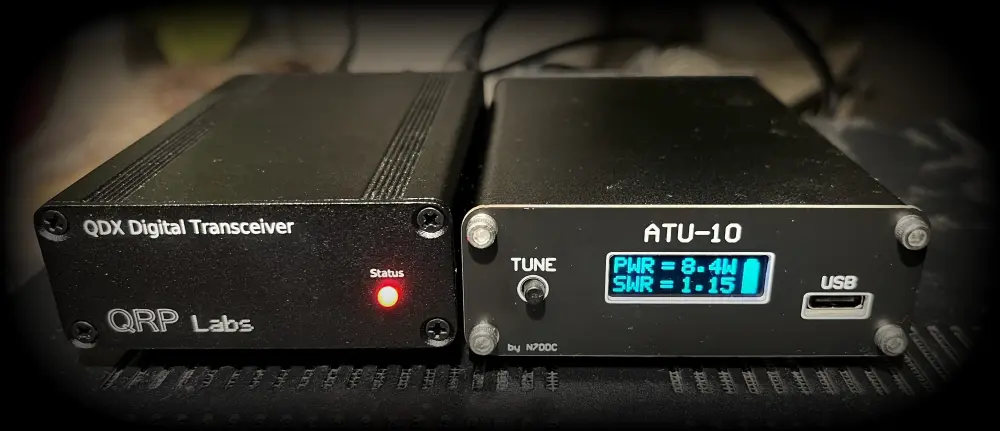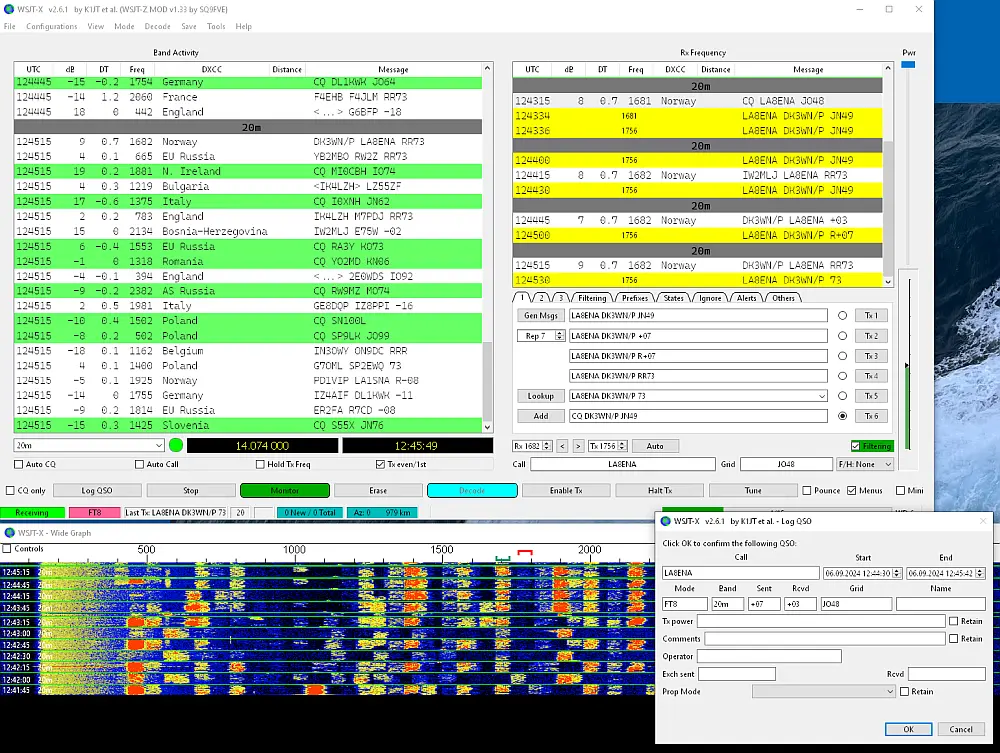
The „QDX“ (QRP Labs Digital Xcvr): a feature-packed, high performance, five-band (80, 60, 40, 30 and 20m) or six high-HF band (20, 17, 15, 12, 11 and 10m) 5W Digi-modes transceiver kit, including embedded SDR receiver, 24-bit 48 ksps USB sound card, CAT control, synthesized VFO with TCXO reference. QDX transmits a SINGLE SIGNAL, it is not an SSB modulator with associated unwanted sideband and residual carrier, or intermodulation due to amplifier non-linearity. QDX outputs a pure single signal.
QDX is suitable only for single tone FSK modes, which covers the majority of digital modes in use today. This includes everything in WSJT-X, JS8Call, some fldigi modes e.g. RTTY, Olivia and more. QDX is not suitable for on/off keyed modes such as CW because it does not have click-reducing RF envelope shaping; furthermore it is not suitable for phase shift keyed modes such as PSK31 or modes involving multiple concurrent tones such as WinLink,
Many thanks to Ross VK1UN for his extensive and tireless assistance designing and testing filters for the high bands version of QDX (20, 17, 15, 12, 11 and 10m version).
The Optional enclosure is black anodized extruded aluminium, very sturdy and elegant. The enclosure size is 89 x 63 x 25mm without protrusions. The front and rear panels are drilled and cut to match the QDX PCB with laser-etched lettering. The enclosure includes four self-adhesive feet.
List of features:
- Five bands version 80, 60, 40, 30 and 20m or six high-bands version 20, 17, 15, 12, 11 and 10m
- 5W output at 9V supply (can be built for 4-5W at 12V supply) – note lower power at higher bands e,g. 10m, approx 3.5-4W
- Single signal transmission (zero unwanted sideband, zero residual carrier, zero intermodulation distortion)
- Solid-state band switching and transmit/receive switching under CAT control
- High performance embedded SDR SSB receiver with 60-70dB of unwanted sideband cancellation
- Built-in 24-bit 48ksps USB sound card
- Built-in USB Virtual COM Serial port for CAT control
- Si5351A Synthesized VFO with 25MHz TCXO as standard
- Easy to build single-board design, Professional quality double-sided, through-hole plated, silk-screen printed PCBs
- All SMD components factory assembled
- Connectors: 2.1mm power barrel connector, USB B (for audio and CAT control), BNC RF input/output
- Built-in test signal generator and testing tools
- Receive current 100mA, Transmit current 1.0-1.1A for 5W output with 9V supply (around 0.7A for 5W with 13V supply).
- I-Q output mode if you wish to use a PC SDR program for demodulation rather than the internal SDR
- QFU firmware update for lifetime free firmware udpates, easy installation on any PC without drivers, software or hardware e.g. programmer
- Optional aluminium extruded cut/drilled/laser-etched black anodized enclosure (88.6 x 63 x 25 mm)
QDX works well on 60m, as documented by John AE5X at https://ae5x.blogspot.com/2021/11/spectrum-analysis-qdx-on-60m.html. Outside the range 3.4-14.5MHz, QDX can be used as a receiver, with some loss of sensitivity. Firmware versions 1.06 onward can operate on any amateur band from 2200m to 4m, but hardware changes will be needed (correct filters etc).
NOTE: Due to the global semiconductor shortage, the price of many ICs has increased dramatically, and there have also been (less drastic) price increases in other parts of the production. Accordingly it has been necessary to pass on some of these costs to the price of the QDX, this is why it is now $69 when the original price was $60 for the first batch. The first batch was produced in Jan 2020, a whole world away.
Portabel Betrieb
In Ergänzung der AFU-Verordnung §11 gibt es eine Verfügung, die die Rufzeichenverwendung im Detail regelt:„Vfg Nr. 12/2005 geändert durch Vfg Nr. 34/2005 Amateurfunkdienst; Rufzeichenplan für den Amateurfunkdienst in Deutschland“
Dort ist unter Punkt 7. Folgendes zu lesen:
„7. International gebräuchliche Rufzeichenzusätze im Sinne von § 11 Abs. 3 AFuV, die an das Rufzeichenende angehängt werden können, sind:
a) beim Betrieb einer beweglichen Amateurfunkstelle in einem Landfahrzeug oder an Bord eines Wasserfahrzeugs auf Binnengewässern das Zeichen „/m“, bei Sprechfunkverkehr das Wort „mobil“,
b) beim Betrieb einer Amateurfunkstelle an Bord eines Wasserfahrzeuges, das sich auf See befindet,das Zeichen „/mm“, bei Sprechfunkverkehr die Wörter „maritim mobil“,
c) beim Betrieb einer Amateurfunkstelle an Bord eines Luftfahrzeugs das Zeichen „/am“, bei Sprechfunkverkehr die Wörter „aeronautisch mobil“,
d) beim Betrieb einer tragbaren oder vorübergehend ortsfest betriebenen Amateurfunkstelle das Zeichen „/p“, bei Sprechfunkverkehr das Wort „portabel“,
e) aus betrieblichen Gründen notwendige Zusätze, die vom Rufzeichen mit einem Bindestrich„-“ oder einem Schrägstrich „/“ getrennt werden.„
Demnach ist es tatsächlich so, wie bereits von den Funkfreunden in ihren Posts weiter oben angegeben, und wie von der Mitarbeiterin der Bundesnetzagentur mir gegenüber erklärt, dass die in der Verfügung unter a) bis d) genannten Zusätze zum Rufzeichen allesamt optional verwendet werden können und nicht zwangsweise verwendet werden müssen.


R6000 / ATU-10 / QDX (07.09.2024)
- 10m = 6.2W SWR 1.00
- 12m = 6.4W SWR 1.33
- 15m = 7.3W SWR 1.31
- 17m = 6.4W SWR 1.09
- 20m = 9.5W SWR 1.15